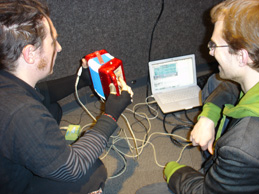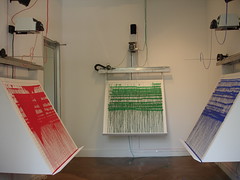Home electronics today are made so cheaply and repair costs are so expensive that it’s usually not worth trying to repair damaged gear. Most repair shops have a bench fee starting at $30/hour and you’ll pay for the full hour even if the repair takes only 30 minutes. You’ll also be charged for parts and diagnostics. Unless you have access to sophisticated electronics test equipment, it’s not easy to trouble-shoot your increasingly complicated, electronically dependent world. Imagine tearing into your cell phone or motherboard to get to the bottom of a malfunctioning micro-part! Most of us can’t figure out how to get the case open, let alone how to do diagnostics and repair. Isn’t there anything a consumer can do without knowing a lot about electronics or having a wirehead’s workbench in the basement? It turns out there is.

1960s General Electric Radio. Watch the skies!
I was recently given an old stereo receiver which was headed for the landfill. It was called the Realistic Modulaire and was manufactured in Japan over 20 years ago by Radio Shack. After years of use, neglect and storage, it was a real mess. The wood case and aluminum channel front panel were covered in a haze of grime. All the “pots” (geekspeak for potentiometers, e.g. volume controls, balance, treble and bass controls) were so dirty that it was impossible to listen to the audio. It was tempting to just give it the ol’ heave-ho! But, I liked the size and design of this icon of ’70s stereos. Its retro style spoke of a bygone electronic heritage, and I figured, if it could be salvaged, it would make a nice foundation for a modest home theater system for our study.
When attempting to salvage old gear, you’ve got to resist the temptation to just “plug ‘er in and give ‘er the smoke test.” With the unit unplugged, it’s best if you can get into the case and visually inspect the top and bottom of the circuit boards and power supply. Do this in good light or use a flashlight if need be. Look for evidence of obvious problems: loose, rotted wires, charred or missing components, damaged circuit boards and the like. If you discover such problems and don’t have the skills to fix them, give the component to an electronically-knowledgeable friend. At the very least, he or she will be glad to have more spare parts and it’ll keep one more thing out of the landfill. If your inspection doesn’t turn up any obvious problems, plug it in and give it the juice!
The Modulaire was an analog tuner — that’s the kind where you twist a knob and a pointer rides along a dial showing what frequency is being tuned. It had a shiny, opaque, black dial which came to life when I turned it on, illuminating gold markings and lettering silkscreened on the inside of the dial. It positively glowed through the haze. I strapped on a pair of headphones and slipped the plug into the phone jack on the front panel. Turning the volume up, my ears were blasted by a horrific scratching sound. I tried the balance, treble and bass knobs and got the same response. It was time to apply my meager restoration skills.

1962/63 Zenith Royal
For years I’ve chatted with a friend of mine who repairs electronic equipment for a living. In the process, I’ve picked up a couple of valuable trouble-shooting tips. The first is: Always check the fuse! He says that often, equipment thought to have been damaged by lightning, or simply worn out, simply needs a new fuse. Most electronic devices including computers, fax machines, stereo gear and satellite receivers, have one or more fuses to protect various circuits from being blown. Most fuses are obvious — they’re located on the back of the device and are clearly labeled. Some, however, are located inside the device. With the unit unplugged, remove the cover and look for circuit board-mounted, glass-type fuses, or plastic circuit breaker boxes. The latter will be small rectangular boxes, usually on edge and mounted to the board. There will often be a label on the board stating that it’s a circuit breaker. There will also be a small white, orange or other color button on top. If the breaker has been tripped, it will click when you push down on it.
The second tip is to spring for a can of Radio Shack Tuner Control Cleaner and Lubricant (RS Cat #64-4315). This is a product which seems too good to be true. It’s a 4.5 ounce spray can which comes with a “flexible extension tube” for spraying its miracle-making contents into tight places. At just US$8 a can, this product will make you look like an electronics genius. Within seconds, you can breathe life back into radios, TVs, car stereos, Walkman tape players, you name it! If it’s got a volume control or switch, it can be cleaned, even without removing the case. In most cases you should be able to pull the knobs off the front of the gear to be fixed. On larger knobs check to see if there’s a small set screw on the side of the knob which needs to be loosened before the knob can be removed.
Once the knobs have been taken off, fit the extension tube into the spray nozzle of the can and place it where the shaft enters the control. This is where the dirt is. Press the nozzle quickly for one short blast. You don’t have to hose the thing down. Now, work the control’s full swing rapidly back and forth for about thirty seconds. On particularly dirty pots or switches, a second or third application may be necessary. Wipe excess spray off with a soft, absorbent cloth. Information on the side of the can claims that it is non-flammable and safe on most plastics, but I don’t think I’d want to breathe too much of it.
After bringing the pots back to life on the Modulaire, I was inspired to finish the job. Using non-abrasive cleaners, I attacked the grime on the case and the front panel. Within minutes they were completely cleaned. I rubbed furniture oil into the wood case and the warm walnut veneer, favored on stereo components from this era, looked like new. The aluminum channel shined brightly and I was delighted to see a bright red pilot bulb light up when a stereo station was tuned.
The unit was given to me with the two speaker cabinets it had when it was originally sold. One speaker was blown and the other was of poor quality. In the years since this product was made, small speaker technology has made some impressive progress. By pulling the original speakers from the case and installing inexpensive Radio Shack replacement speakers, I’ve now got a respectable, if not chest-pounding, audio system for the TV in the study.
Finally, here’s a tip on dealing with Radio Shack products. Their website is extremely well done. After you’re at the homepage, click on “support.” Here you can print out manuals for their entire line of audio, video, telephones, scanners and CBs as well as all their computers and peripherals. In addition, you can download software updates, recovery and computer setup programs. Entering the model number I copied from the back of the Modulaire, I was able to print out a user’s manual in minutes, replacing the original which was lost years ago. Unfortunately, they don’t have service manuals or schematics online.
After the success I had with the Modulaire, I was inspired to roam the house fixing every scratchy volume control and intermittent switch I could squirt with the cleaner. I rejuvenated everything from old click-stop TV sets to the radio in my wife’s car. You just can’t beat the satisfaction of saving money on repairs and earning the admiration of friends and family, all for a measly eight bucks!
– Ken Reitz [1/22/99]




















 Alberto Gaitán: Remembrancer (Part 2 of 2: The Software) Alberto Gaitán is a composer/programmer/artist who creates a wide range of new media work.
Alberto Gaitán: Remembrancer (Part 2 of 2: The Software) Alberto Gaitán is a composer/programmer/artist who creates a wide range of new media work. 
